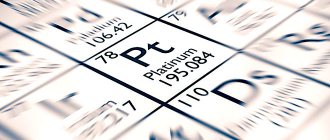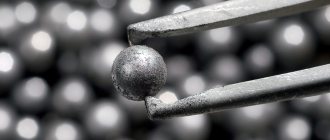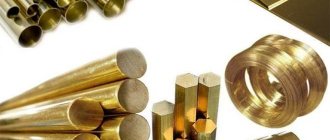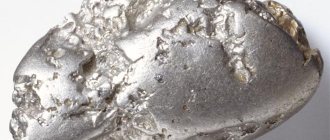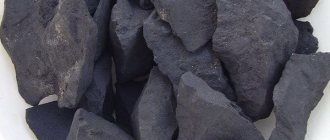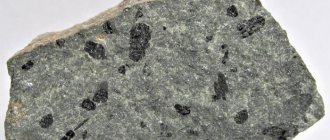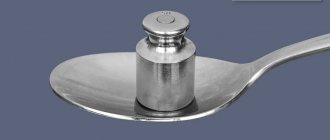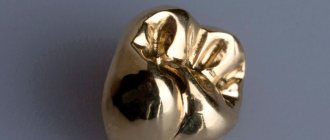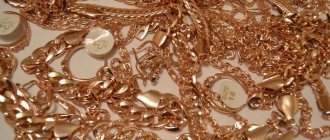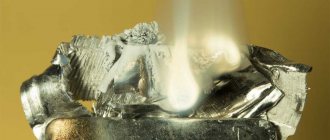A piece of pure aluminum
Aluminum
- a very rare mineral of the copper-cupalite family, a subclass of metals and intermetallic compounds of the class of native elements. Mainly in the form of microscopic deposits of a continuous fine-grained structure. It can form lamellar or scaly crystals up to 1 mm, whiskers up to 0.5 mm long are noted. with a thread thickness of several microns. A lightweight paramagnetic metal of silver-white color, easy to form, cast, and machine.
- Structure
- Properties
- Reserves and production
- Origin
- Application
- Classification
- Physical properties
- Optical properties
- Crystallographic properties
See also:
Ice
– structure and physical properties
Copper
– structure and physical properties
STRUCTURE
Cubic face-centered structure. 4 orange atoms
The crystal lattice of aluminum is a face-centered cube, which is stable at temperatures from 4°K to the melting point. There are no allotropic transformations in aluminum, i.e. its structure is permanent. The unit cell consists of four atoms with a size of 4.049596×10-10 m; at 25 °C, the atomic diameter (the shortest distance between atoms in the lattice) is 2.86 × 10-10 m, and the atomic volume is 9.999 × 10-6 m3/g-atom. Impurities in aluminum have little effect on the lattice parameter. Aluminum has great chemical activity; the energy of formation of its compounds with oxygen, sulfur and carbon is very high. In the voltage series, it is among the most electronegative elements, and its normal electrode potential is -1.67 V. Under normal conditions, interacting with atmospheric oxygen, aluminum is covered with a thin (2-10-5 cm) but durable film of aluminum oxide A1203, which protects against further oxidation, which determines its high corrosion resistance. However, if Hg, Na, Mg, Ca, Si, Cu and some other elements are present in aluminum or the environment, the strength of the oxide film and its protective properties are sharply reduced.
Transport
Aluminum in passenger cars
The average weight of aluminum in passenger cars in Europe in 2006 was about 118 kg and continued to increase. Its share in various components and parts of cars is (in kilograms per car):
- engine cylinder blocks: 40.3
- transmission: 16.3
- Chassis, suspension and handling: 12.5
- wheels: 17.7
- heat exchanger: 12.3
- brakes: 3.7
- body: 6.8
- heat shields: 1.4
- bumpers: 2.8
- other components: 3.9.
PROPERTIES
Native aluminum. Field of view 5 x 4 mm. Azerbaijan, Gobustan region, Caspian Sea, Here-Zira or Bulla Island
Aluminum is a soft, lightweight, silver-white metal with high thermal and electrical conductivity, and is paramagnetic. Melting point 660°C. The advantages of aluminum and its alloys include its low density (2.7 g/cm3), relatively high strength characteristics, good thermal and electrical conductivity, manufacturability, and high corrosion resistance. The combination of these properties allows us to classify aluminum as one of the most important technical materials. It is easily drawn into wire and rolled into thin sheets. Aluminum is chemically active (in air it becomes covered with a protective oxide film - aluminum oxide) and reliably protects the metal from further oxidation. But if aluminum powder or aluminum foil is heated strongly, the metal burns with a blinding flame, turning into aluminum oxide. Aluminum dissolves even in dilute hydrochloric and sulfuric acids, especially when heated. But aluminum does not dissolve in highly diluted and concentrated cold nitric acid. When aqueous solutions of alkalis act on aluminum, the oxide layer dissolves, and aluminates are formed - salts containing aluminum as part of the anion.
Metal connections
Alloys are obtained by artificially adding other metals to aluminum in order to obtain the necessary properties. And today there is an endless number of compositions of such alloys that have the widest application.
- The most famous area of their application is aircraft manufacturing. For the production of aircraft, alloys consisting of aluminum, zinc and magnesium are used, which results in a super-strong and reliable material.
- Alloys of aluminum with iron, titanium, and nickel are also often used.
If you want to make something out of aluminum yourself, the following video will tell you how to melt it at home:
Source
RESERVES AND PRODUCTION
Aluminum pieces
In terms of prevalence in the Earth's crust, it ranks 1st among metals and 3rd among elements, second only to oxygen and silicon. The mass concentration of aluminum in the earth's crust, according to various researchers, is estimated from 7.45 to 8.14%. The modern production method, the Hall-Héroult process, was developed independently by the American Charles Hall and the Frenchman Paul Héroult in 1886. It consists of dissolving aluminum oxide Al2O3 in molten cryolite Na3AlF6, followed by electrolysis using consumable coke or graphite anode electrodes. This production method requires very large amounts of electricity, and therefore received industrial application only in the 20th century.
Production of aluminum.
The documented discovery of aluminum occurred in 1825. This metal was first obtained by the Danish physicist Hans Christian Oersted, when he isolated it by the action of potassium amalgam on anhydrous aluminum chloride (obtained by passing chlorine through a hot mixture of aluminum oxide and coal). Having distilled off the mercury, Oersted obtained aluminum, although it was contaminated with impurities. In 1827, the German chemist Friedrich Wöhler obtained aluminum in powder form by reducing hexafluoroaluminate with potassium:
Na3AlF6 + 3K ® Al + 3NaF + 3KF. Later he managed to obtain aluminum in the form of shiny metal balls. In 1854, the French chemist Henri Etienne Saint-Clair Deville developed the first industrial method for producing aluminum - by reducing the melt of tetrachloroaluminate with sodium: NaAlCl4 + 3Na ® Al + 4NaCl. However, aluminum continued to be an extremely rare and expensive metal; it was not much cheaper than gold and 1500 times more expensive than iron (now only three times). A rattle was made from gold, aluminum and precious stones in the 1850s for the son of French Emperor Napoleon III. When a large ingot of aluminum produced by a new method was exhibited at the World Exhibition in Paris in 1855, it was looked upon as if it were a jewel. The upper part (in the form of a pyramid) of the Washington Monument in the US capital was made from precious aluminum. At that time, aluminum was not much cheaper than silver: in the USA, for example, in 1856 it was sold at a price of 12 dollars per pound (454 g), and silver for 15 dollars. In the 1st volume of the famous Brockhaus Encyclopedic Dictionary published in 1890, Efron said that “aluminum is still used primarily for the manufacture of... luxury goods.” By that time, only 2.5 tons of metal were mined annually throughout the world. Only towards the end of the 19th century, when an electrolytic method for producing aluminum was developed, its annual production began to amount to thousands of tons, and in the 20th century. – million tons. This transformed aluminum from a semi-precious metal to a widely available metal.
The modern method of producing aluminum was discovered in 1886 by a young American researcher, Charles Martin Hall. He became interested in chemistry as a child. Having found his father's old chemistry textbook, he began to diligently study it and carry out experiments, once even receiving a scolding from his mother for damaging the dinner tablecloth. And 10 years later he made an outstanding discovery that made him famous throughout the world.
As a student at age 16, Hall heard from his teacher, F. F. Jewett, that if someone could develop a cheap way to produce aluminum, that person would not only do a great service to humanity, but also make a huge fortune. Jewett knew what he was saying: he had previously trained in Germany, worked with Wöhler, and discussed with him the problems of producing aluminum. Jewett also brought a sample of the rare metal with him to America, which he showed to his students. Suddenly Hall declared publicly: “I will get this metal!”
Six years of hard work continued. Hall tried to obtain aluminum using different methods, but without success. Finally, he tried to extract this metal by electrolysis. At that time there were no power plants; current had to be generated using large homemade batteries from coal, zinc, nitric and sulfuric acids. Hall worked in a barn where he set up a small laboratory. He was helped by his sister Julia, who was very interested in her brother’s experiments. She preserved all his letters and work journals, which make it possible to literally trace the history of the discovery day by day. Here is an excerpt from her memoirs:
“Charles was always in a good mood, and even on the worst days he was able to laugh at the fate of unlucky inventors. In times of failure, he found solace at our old piano. In his home laboratory he worked for long hours without a break; and when he could leave the set up for a while, he would rush across our long house to play a little... I knew that, playing with such charm and feeling, he was constantly thinking about his work. And music helped him with this.”
The most difficult thing was to select an electrolyte and protect the aluminum from oxidation. After six months of exhausting labor, several small silver balls finally appeared in the crucible. Hall immediately ran to his former teacher to tell him about his success. “Professor, I got it!” he exclaimed, holding out his hand: in his palm lay a dozen small aluminum balls. This happened on February 23, 1886. And exactly two months later, on April 23 of the same year, the Frenchman Paul Héroux took out a patent for a similar invention, which he made independently and almost simultaneously (two other coincidences are also striking: both Hall and Héroux were born in 1863 and died in 1914).
Now the first balls of aluminum produced by Hall are kept at the American Aluminum Company in Pittsburgh as a national relic, and at his college there is a monument to Hall, cast from aluminum. Jewett subsequently wrote: “My most important discovery was the discovery of man. It was Charles M. Hall who, at the age of 21, discovered a method of reducing aluminum from ore, and thus made aluminum that wonderful metal which is now widely used throughout the world.” Jewett's prophecy came true: Hall received wide recognition and became an honorary member of many scientific societies. But his personal life was unsuccessful: the bride did not want to come to terms with the fact that her fiancé spends all his time in the laboratory, and broke off the engagement. Hall found solace in his native college, where he worked for the rest of his life. As Charles’s brother wrote, “College was his wife, his children, and everything else—his whole life.” Hall bequeathed the majority of his inheritance to the college - $5 million. Hall died of leukemia at the age of 51.
Hall's method made it possible to produce relatively inexpensive aluminum on a large scale using electricity. If from 1855 to 1890 only 200 tons of aluminum were obtained, then over the next decade, using Hall’s method, 28,000 tons of this metal were already obtained worldwide! By 1930, global annual aluminum production reached 300 thousand tons. Now more than 15 million tons of aluminum are produced annually. In special baths at a temperature of 960–970 ° C, a solution of alumina (technical Al2O3) in molten cryolite Na3AlF6, which is partially mined in the form of a mineral, and partially specially synthesized, is subjected to electrolysis. Liquid aluminum accumulates at the bottom of the bath (cathode), oxygen is released at the carbon anodes, which gradually burn. At low voltage (about 4.5 V), electrolysers consume huge currents - up to 250,000 A! One electrolyzer produces about a ton of aluminum per day. Production requires a lot of electricity: it takes 15,000 kilowatt-hours of electricity to produce 1 ton of metal. This amount of electricity is consumed by a large 150-apartment building for a whole month. Aluminum production is environmentally hazardous, since the atmospheric air is polluted with volatile fluorine compounds.
ORIGIN
Aluminum aggregated with a bayerite crust on the surface. Uzbekistan, Navoi region, Uchkuduk
Due to its high chemical activity, it is not found in pure form, but only as part of various compounds. For example, there are many known ores, minerals, and rocks that contain aluminum. However, it is extracted only from bauxite, the content of which in nature is not very high. The most common substances containing the metal in question are: feldspars; bauxite; granites; silica; aluminosilicates; basalts and others. In small quantities, aluminum is necessarily found in the cells of living organisms. Some species of club mosses and marine inhabitants are capable of accumulating this element inside their bodies throughout their lives.
Product packaging
Rolled aluminum – strips and foil – are used in the packaging of bulk and liquid products. Aluminum packaging accompanies us everywhere in our lives - for example, aluminum cans and bottles, foil in food and medicine packaging. Aluminum has low density, food and beverage compatibility, and an attractive appearance. This makes it an ideal material for various types of packaging: hard (cans) and soft (foil).
Aluminum cans for food packaging [6]
Aluminum cans
Aluminum is used to make 75% of beverage cans and 15% of aerosol containers. Aluminum cans provide a significant reduction in packaging weight compared to similar steel cans.
APPLICATION
Aluminum decoration
Widely used as a construction material. The main advantages of aluminum in this quality are lightness, malleability for stamping, and corrosion resistance. The electrical conductivity of aluminum is only 1.7 times less than that of copper, while aluminum is approximately 4 times cheaper per kilogram, but due to its 3.3 times lower density, to obtain equal resistance it needs approximately 2 times less weight . Therefore, it is widely used in electrical engineering for the manufacture of wires, their shielding, and even in microelectronics when depositing conductors on the surface of microcircuit crystals. When aluminum was very expensive, a variety of jewelry was made from it. Thus, Napoleon III ordered aluminum buttons, and in 1889 Mendeleev was presented with scales with bowls made of gold and aluminum. The fashion for jewelry made of aluminum immediately passed when new technologies for its production appeared, reducing the cost many times over. Nowadays, aluminum is sometimes used in the production of costume jewelry.
Aluminum – Al
| Molecular weight | 26.98 g/mol |
| origin of name | from Latin alumen |
| IMA status | approved in 1978 |
Construction
Aluminum windows and facades
The main aluminum alloys that are used in the construction industry are alloys 6063 and 6060, as well as alloy 6082 (in Europe) and alloy 6061 (in North America). They have fairly high strength (6082 and 6061 - up to 400 MPa) and good corrosion resistance.
Window aluminum profiles with thermal decoupling (alloys 6060/6063)
The most important structural characteristics of aluminum, which determine the use of aluminum as a material for window and door frames:
- strength for rigidity and safety;
- the ability to take complex shapes (provided by extrusion);
- attractive appearance;
- corrosion resistance;
- minimal need for maintenance.
Curtain facade with aluminum frame (alloys 6060/6063)
Aluminum roofing and aluminum cladding of buildings
Decorative and protective profiled cladding materials are often made from rolled aluminum sheets. Various types of decorative and protective coatings make them ideal materials for use as roofing materials.
Application for roofing and cladding of buildings provides the following properties of aluminum:
- low weight due to low density;
- resistance to water;
- corrosion resistance;
- decorative look.
Differences between aluminum alloys
AD1 alloys
are technical aluminum, contain up to 0.7% impurities, among which the main role belongs to silicon and iron. They are resistant to chemicals. Suitable as materials for tanks, gaskets, washers. AD31 is prone to hardening during heat treatment, contains: Al, Mg, Si. It has high ductility and is not susceptible to rust. It produces complex-shaped semi-finished products. It is easy to process and lends itself well to coloring. Profiles and containers for transporting nitric acid and food products are obtained from it. It is also a material for flasks, cans, and bottle caps.
In alloy B95
, in addition to Al, zinc, magnesium and copper are present. The most durable among all varieties, therefore it is in demand in structures with high loads. Plates, strips, and profiles are produced from it. Under point load, it is prone to corrosive destruction.
D16
very common, is an aluminum alloy with copper and magnesium. It can be deformed in cold and hot conditions. Not intended for welding. Alloy D16t is duralumin, in demand in aircraft and shipbuilding. Three times lighter than steel, not subject to microscopic deformation. Works well on lathes. The letter T means that it is artificially aged. In this state it is very durable and not susceptible to corrosion.
Under the designation AMG
should be understood as aluminum-magnesium alloys. Not hardened by heat treatment. Indispensable in deep stamping technologies. Frost-resistant, plastic. The numbers following the letters indicate the amount of magnesium.
Alloy A5
– primary aluminum, from which wire, foil, and ingots are made.
AMC
contains aluminum and manganese. Plastic, but low strength. Among the advantages of such alloys are resistance to corrosion and the ability to be easily welded by resistance, gas, or atomic-hydrogen welding. Prone to deformation in both cold and hot states within the range of 320-470 ° C.
Decrease temperature
Before you start melting metal, you can perform certain operations that will reduce the melting temperature. For example, sometimes aluminum powder is melted. In a powdered state, the metal begins to melt somewhat faster. But with such processing, there is a real danger that when interacting with oxygen contained in the atmosphere, aluminum powder will begin to oxidize with a large release of heat and the formation of metal oxides; this process occurs at a temperature of 2300 degrees. The main thing is to prevent contact between the melt and water at this moment of melting. This will cause an explosion.
